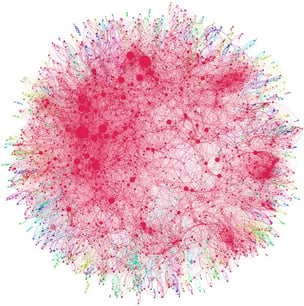 Co-authorship network map of 8,500 doctors and scientists publishing on hepatitis C between 2008 and 2012 and the almost 60,000 co-authorship relationships between them. Photo via Andy Lamb
Co-authorship network map of 8,500 doctors and scientists publishing on hepatitis C between 2008 and 2012 and the almost 60,000 co-authorship relationships between them. Photo via Andy Lamb
Content marketing strategy and the leveraging of big data.
Of the many popular expressions coined and used over the last decade, there is one that seems to have proliferated in every industry, “Big Data.” Whether you are reading a business journal, reading about IT or doing your own research, you are bound to come across the term often. First, let’s define Big Data. According to Wikipedia, “Big Data is the term for a collection of data sets so large and complex that it becomes difficult to process using on-hand database management tools or traditional data processing applications. The challenges include capture, curation, storage, search, sharing, transfer, analysis and visualization.”
The reason why big data has become so exciting is because a very large set of related data, as opposed to many smaller sets of data comprising the same amount of data in the aggregate, allows for correlations to be found that can have far reaching implications, such as, for instance, the prevention of disease or crime. The same big data applications are now happening in marketing. As savvy marketers continue to capture audience data using cookies and non-cookie technologies, they are building a wealth of big data that can be analyzed to draw correlations on consumer behavior. Audience models can be built to identify the types of web sites and activities certain personas are exhibiting. Ultimately data-driven audiences will lead to better targeting and more efficient media buying initiatives.
One of the most interesting applications for big data in marketing is to develop custom content and messaging. Each audience can be identified based on common correlated factors and then messaged with custom content at various stages of the buying cycle. For example, a user who is researching the purchase of a paddleboard might have a data profile that exhibits that they visit outdoors related web sites online, purchase eco-friendly products and eat organic foods. By creating content related to paddleboarding such as, “Top Eco-Friendly Campsites for Paddleboarding”, a marketer could capture the attention of the target persona and start engagement. If the marketer then creates content hubs on their web site around paddleboards, ideally with content pieces that progress through the buying process – “What is Paddleboarding?”, “Health Benefits of Paddleboarding”, “How to Choose the Right Paddleboard” – the advertiser will have a much better likelihood of converting this target user into a customer when they are ready to make a purchase. Standard merchandizing dynamics will still be in play, but an advertiser who can create valuable content that aids a consumer will have a much stronger brand affinity in that consumer’s eyes. This will ultimately lead to higher conversion rates and more sales for the brand.
These days content is everywhere and is popping up “natively” within web sites and apps across the web and on devices of all types. Leveraging a smart data-driven content strategy, both on and off site, will become more and more important as the cross section between Big Data and Native Advertising grows. The marketers who understand how to execute a modern content strategy in today’s web 2.0 world will be at a keen advantage to those who do not.



COMMENTS